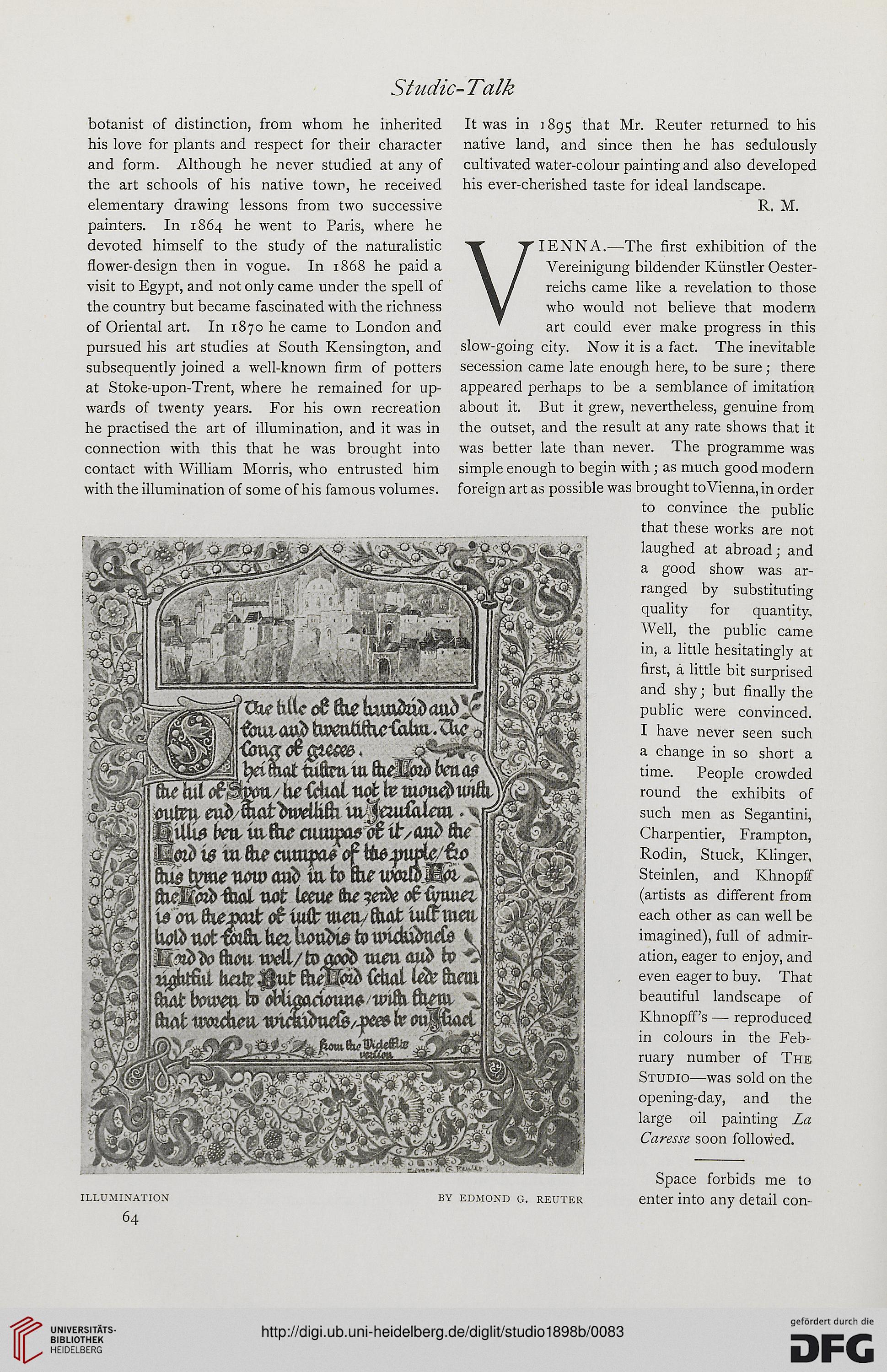Studic-Talk
bet foot tufcum venae \
%ehdof$mx/he (dd not be mrndwtd
outra ed/mdhvMfk xdjezuCxlem. \rr
®iUw ben, mfhr cnmipxsoi it/ad> the :
i$ m fti* cutojpa* of {hejpvde/(u>
fhlat^ turn? gift into
not teeue foe?exte&fymei',
is atv fti&rxttfc c£ iufb tuetv 6wt tuff mm
botanist of distinction, from whom he inherited
his love for plants and respect for their character
and form. Although he never studied at any of
the art schools of his native town, he received
elementary drawing lessons from two successive
painters. In 1864 he went to Paris, where he
devoted himself to the study of the naturalistic
flower-design then in vogue. In 1868 he paid a
visit to Egypt, and not only came under the spell of
the country but became fascinated with the richness
of Oriental art. In 1870 he came to London and
pursued his art studies at South Kensington, and
subsequently joined a well-known firm of potters
at Stoke-upon-Trent, where he remained for up-
wards of twenty years. For his own recreation
he practised the art of illumination, and it was in
connection with this that he was brought into
contact with William Morris, who entrusted him
with the illumination of some of his famous volumes.
It was in 1895 that Mr. Reuter returned to his
native land, and since then he has sedulously
cultivated water-colour painting and also developed
his ever-cherished taste for ideal landscape.
R. M.
VIENNA.—The first exhibition of the
Vereinigung bildender Kiinstler Oester-
reichs came like a revelation to those
who would not believe that modem
art could ever make progress in this
slow-going city. Now it is a fact. The inevitable
secession came late enough here, to be sure; there
appeared perhaps to be a semblance of imitation
about it. But it grew, nevertheless, genuine from
the outset, and the result at any rate shows that it
was better late than never. The programme was
simple enough to begin with ; as much good modern
foreign art as possible was brought to Vienna, in order
to convince the public
that these works are not
laughed at abroad; and
a good show was ar-
ranged by substituting
quality for quantity.
Well, the public came
in, a little hesitatingly at
first, a little bit surprised
and shy; but finally the
public were convinced.
I have never seen such
a change in so short a
time. People crowded
round the exhibits of
such men as Segantini,
Charpentier, Frampton,
Rodin, Stuck, Klinger,
Steinlen, and Khnopff
(artists as different from
each other as can well be
imagined), full of admir-
ation, eager to enjoy, and
even eager to buy. That
beautiful landscape of
Khnopff’s — reproduced
in colours in the Feb-
ruary number of The
Studio—was sold on the
opening-day, and the
large oil painting La
Caresse soon followed.
Space forbids me to
enter into any detail con-
ILLUMINATION
64
BY EDMOND G. REUTER
bet foot tufcum venae \
%ehdof$mx/he (dd not be mrndwtd
outra ed/mdhvMfk xdjezuCxlem. \rr
®iUw ben, mfhr cnmipxsoi it/ad> the :
i$ m fti* cutojpa* of {hejpvde/(u>
fhlat^ turn? gift into
not teeue foe?exte&fymei',
is atv fti&rxttfc c£ iufb tuetv 6wt tuff mm
botanist of distinction, from whom he inherited
his love for plants and respect for their character
and form. Although he never studied at any of
the art schools of his native town, he received
elementary drawing lessons from two successive
painters. In 1864 he went to Paris, where he
devoted himself to the study of the naturalistic
flower-design then in vogue. In 1868 he paid a
visit to Egypt, and not only came under the spell of
the country but became fascinated with the richness
of Oriental art. In 1870 he came to London and
pursued his art studies at South Kensington, and
subsequently joined a well-known firm of potters
at Stoke-upon-Trent, where he remained for up-
wards of twenty years. For his own recreation
he practised the art of illumination, and it was in
connection with this that he was brought into
contact with William Morris, who entrusted him
with the illumination of some of his famous volumes.
It was in 1895 that Mr. Reuter returned to his
native land, and since then he has sedulously
cultivated water-colour painting and also developed
his ever-cherished taste for ideal landscape.
R. M.
VIENNA.—The first exhibition of the
Vereinigung bildender Kiinstler Oester-
reichs came like a revelation to those
who would not believe that modem
art could ever make progress in this
slow-going city. Now it is a fact. The inevitable
secession came late enough here, to be sure; there
appeared perhaps to be a semblance of imitation
about it. But it grew, nevertheless, genuine from
the outset, and the result at any rate shows that it
was better late than never. The programme was
simple enough to begin with ; as much good modern
foreign art as possible was brought to Vienna, in order
to convince the public
that these works are not
laughed at abroad; and
a good show was ar-
ranged by substituting
quality for quantity.
Well, the public came
in, a little hesitatingly at
first, a little bit surprised
and shy; but finally the
public were convinced.
I have never seen such
a change in so short a
time. People crowded
round the exhibits of
such men as Segantini,
Charpentier, Frampton,
Rodin, Stuck, Klinger,
Steinlen, and Khnopff
(artists as different from
each other as can well be
imagined), full of admir-
ation, eager to enjoy, and
even eager to buy. That
beautiful landscape of
Khnopff’s — reproduced
in colours in the Feb-
ruary number of The
Studio—was sold on the
opening-day, and the
large oil painting La
Caresse soon followed.
Space forbids me to
enter into any detail con-
ILLUMINATION
64
BY EDMOND G. REUTER




